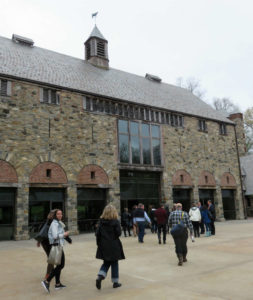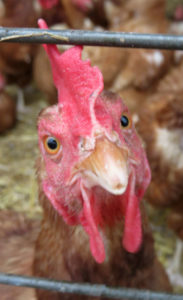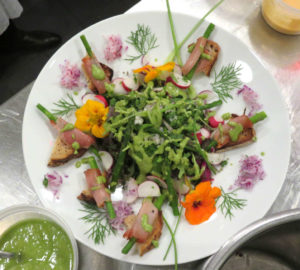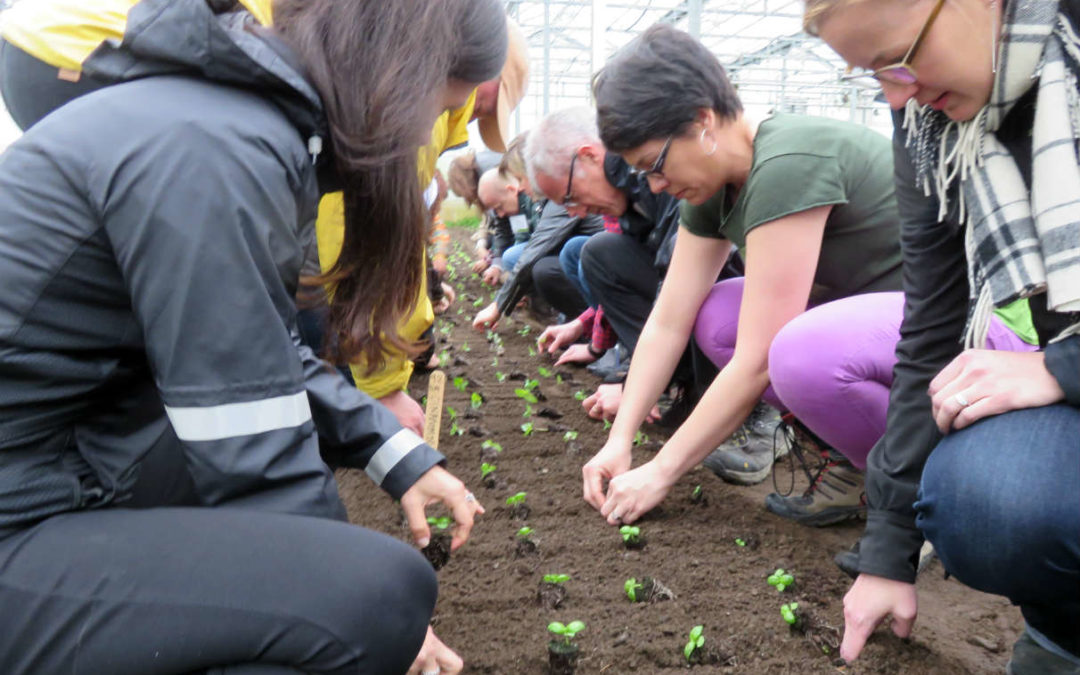From the Greatest Generation to Generation Z and the Baby Boomers and Millenials in between, we are all connected by one simple necessity–We All Eat! Some of us are Feeders–just putting food in our mouths to combat hunger, some of us are Eaters–being deliberate about what we eat, perhaps watching calories and sugar and fat quantities, and some of us are Diners or possibly Foodies –searching for the freshest, most sustainably grown ingredients at a farmers market and frequenting the Farm to Table restaurants. Then some of us are gluten-free, lactose intolerant, watching our weight or bulking on protein. However, in the end, no matter our food persuasion, we all must eat to survive. Food is grown on land, in water, and in pots and trays. Without food, we have no live(s)-lihoods!

Entering the Stone Barns Conference Center
The Urban Land Institute (ULI), a worldwide organization of real estate professionals has recognized that the link between food and built environment is weak and sees the importance of strengthening it. Rather than building golf course master planned communities, suburban mass-market malls, or ensuring that the rent-reliable bank is located on a prime urban corner, authentic food-focused real estate projects are sprouting up across the nation creating excitement and fun. With this increased attention to integrate good food into development projects, ULI recently hosted two Food & Real Estate Forums to begin to decipher, understand, and share information on what it takes to generate successful food-focused real estate projects. The day before the typical conference proceedings of presentations, panels, and discussions, the Food Forum attendees got educated, built community and had fun with activities at Stone Barns Center for Food & Agriculture in Tarrytown, New York.
The Stone Barns Center is located one hour north of New York City in the Hudson River Valley on 80 acres of former dairy property originally owned and developed by the Rockefeller family in the 1930’s. The surrounding countryside is vistas of rolling hills, fields and forests with large homesteads despite being minutes away from the tentacles of the nation’s interstate highway system. This was a perfect locale for professionals steeped in the culture of the urban environment to explore the sustainable food system’s teachings at Stone Barns.
So, what happens when 70 real estate professionals are given a task? It gets done. Give them a challenge? It’s a competition.
The Coop Hoops

Stone Barn Laying Hen
Slogging in big rubber boots and bundled with a tightly wound scarves in 50° rain, we left Stone Barns’ warm conference space to trudge across the chilly farm. First stop–the hen house. With umbrellas raised, we peered into a large permanent hoop house as laying hens scurried across straw covered floors stopping at grain feeders to peck for their meal. These laying hens, female chickens that produce eggs, are raised with plenty of indoor space and with much coveted outdoor space nestled between an adjoining hoop house. Outside the hens scrounge for bugs to augment their diets. Nesting boxes line the outside edges wall of each hoop house. In winter months about 400 birds are kept, while the summer flock increases to about 1,300 layers. Egg production is significantly reduced in the winter, not only because of the smaller flock, but also because chickens lay up to a 33% fewer eggs just because of the colder, darker days.
Adjacent to the hen house is the chicken coop, another large permanent hoop structure. It is set up differently than the hen house, as it is designed to grow broiler or meat birds. Inside, the coop is divided by wire mesh fencing to create separate living areas for different aged broods of Cornish Cross and Freedom Rangers meat birds, which are both conventionally raised chickens rather than heritage breeds. Conventionally raised birds are ready for eating when they are four months old, while heritage breeds, those that our forefathers grew, need seven months to grow to maturity. Obviously, chickens that live longer need more feed and are therefore more expensive. All the chicks begin their life at a Pennsylvanian hatchery and are shipped via post as day old fledglings to Stone Barns. The baby chicks bunch together beneath a heat lamp trying to stay warm and only venturing out of their brood to visit the grain feeder. Once the chicks are between three to six weeks old depending on the outdoor temperature, the heat lamp is removed. Eventually the chickens are put out to pasture in a rotational grazing sequence with other animals to complete their growth before harvesting them.
The Greenhouse
From the drizzly cold, we were led into the steamy, hot 22,000 square foot greenhouse, where Farmer Jason, taught us about his operation. Besides growing food for Chef Dan Barber’s Blue Hills at Stone Barns Restaurant, the greenhouse farmers breed plant varieties and experiment with seeds. During our early May visit, about half of the greenhouse was sown in oats and clover as rotational crops to return nutrients and health back to the soil. A quarter of the greenhouse ground was tilled, raked, and ready for planting, while the remaining ground was planted in radishes, lettuces, and other greens.

Real Estate Professionals Planting Basil
In one row, a curly-leaf lettuce variety was tightly tied with rubber bands to prevent sunlight from hitting the inner leaves thereby producing pale green leaves for a future specialty salad. I have eaten white rather than green asparagus during Spargelzeit (asparagus time) in Germany. Farmer Jason said, “Reducing or eliminating the sunlight to vegetables is a specialized technique that isn’t used that often because it is so labor intensive.” He went on to explain that the German’s have perfected Bleichspargel or bleached asparagus, by continually mounding soil around the sprouting vegetable, preventing any sunlight from tingeing the spears green. Farmer Jason alleged, “Preventing vegetables from getting sunlight produces a milder and perhaps more tender vegetable.” We didn’t get to taste test the bleached lettuce, but I’m curious. Maybe I’ll need to try technique in my own garden. Despite the cold, dreary day, Farmer Jason knew that summer was right around the corner and he had ready hands available for a springtime planting. Crouching down on either side of a two-foot wide planting bed, we planted 50 feet of Italian basil starts. Ungloved fingers dug a small hole to drop and tamp each sprouted herb into the dirt.
The Kitchen
Next stop the kitchen. Shedding wet coats and donning white aprons, then the hand washing station, which is absolutely necessary after digging in the dirt. Once reassembled with clean hands, Chef Adam, holding a bright red globe radish by its leaves, introduced our cooking challenge. “I’ll divide you into three groups of eight people. Your task, in 15 minutes, is to create a dish using all of this vegetable. Your dish will be evaluated on flavor, presentation, and creative use of your radish–the whole radish, not just the red part. Points will be lost for any waste.” Behind him was a table full of ingredients to use in our dish plus knives, plates, a blender, broiler, other equipment, and a prep station for each team.

The 15 Minute Salad
Our team–defacto strangers up until now– huddled in our prep area to plan our dish. Moments later, Bry and Bill foraged at the ingredient table, knowing whatever they picked had to be used in whole or it would be classified as waste. I shredded red, purple and white radishes and chopped radish leaves to beautify, flavor, and top the salad. Another teammate grilled prosciutto and wrapped it around individual green asparagus spears to top thin slices of toasted baguette, while others mixed salad greens and artfully arranged edible flowers. Kristina gathered all the leftover radish parts–leaves and roots, added fennel tops and walnuts into a blender. As the blender whirred, she drizzled olive oil, added garlic, salt and pepper and who knows what else to create an outstanding green dressing. Chef Adam gave us a two minute warning. John, the father of a professional chef, grabbed the camera to record our effort, as we feverishly assembled and decorated the plate and poured on the dressing. With a sigh of relief, our only waste was excess dressing, which we intended to “bottle and sell.”
Three exquisitely arranged dishes all with the lowly spring radish as its signature vegetable adorned the judge’s table. Chef Adam sang praise for the teamwork he had seen, as each cohort team had taken a couple precious minutes at the competition start to huddle and strategize. In the end, our dish didn’t win, but it sure tasted marvelous–just enough bitterness, sweetness, saltiness, and sharpness. I think it needed just a bit more of our “for sale” dressing to make it sing!
Creating Community
At the cocktail hour, dinner, and the next day sessions there were new connections and common interests, as we had created community with a shared food making experience. It takes me back to the days when I was a kid baking Christmas cookies with my Oma or picking blackberries on the “back 40” and making jam with my Grandma. Picking produce or preparing a meal with family, friends and even business colleagues is a great way to learn, grow, and have fun together! It gets us out of our heads and into our bellies, building friendships, relationships, and memories.

